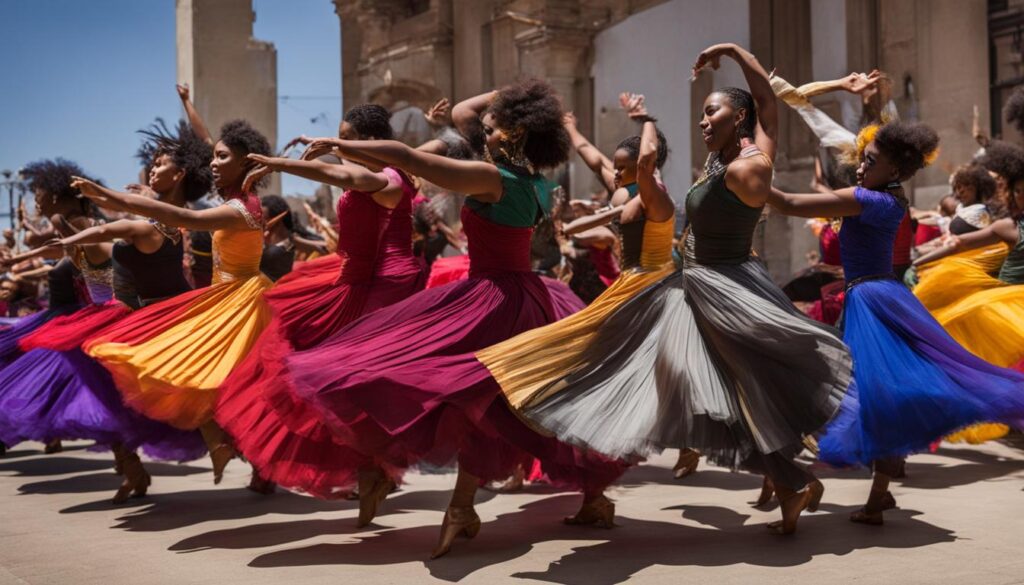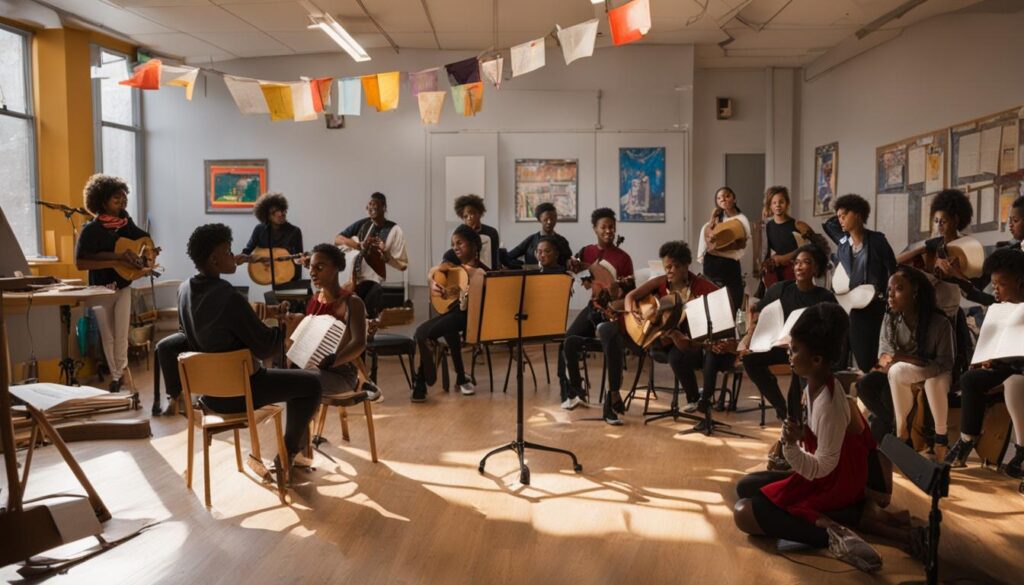Performing arts, a term that encompasses a wide range of artistic expressions, is a diverse and vibrant world filled with creativity and cultural significance. From music to dance and theatre to pantomime, performing arts captivate audiences and showcase the boundless possibilities of human imagination and talent.
So, what exactly is performing arts? It refers to various art forms where artists use their bodies, voices, and/or instruments to convey emotions, tell stories, and engage with audiences. These art forms are not limited to a single medium but include vocal and instrumental music, dance, theatre, opera, recitation, and more. Each form has its own unique characteristics, techniques, and cultural contexts.
Through performing arts, individuals can express themselves, explore different perspectives, and connect with others on an emotional level. It is a powerful tool for storytelling, self-expression, and communication. Whether it’s a thrilling musical performance, a captivating dance routine, or a thought-provoking theatrical production, performing arts have the ability to transport us to new worlds, evoke emotions, and inspire us.
Key Takeaways:
- Performing arts encompass various art forms such as music, dance, theatre, and more.
- Performing arts allow artists to express themselves and connect with audiences emotionally.
- They offer a platform for storytelling, self-expression, and communication.
- Performing arts showcase the diverse cultural expressions and creativity of humanity.
- Whether it’s music, dance, or theatre, performing arts have the power to captivate and inspire.
The Importance and Benefits of Performing Arts
Performing arts play a crucial role in society by providing a platform for artistic expression and creativity. They allow individuals to convey emotions, opinions, and messages through performances. Additionally, engaging in performing arts has numerous benefits, including personal development, increased self-confidence, improved communication skills, and a sense of community.
Participating in performing arts fosters personal growth and development. It encourages individuals to explore their creativity, think outside the box, and push their boundaries. Whether it’s playing an instrument, dancing, or acting, performing arts require dedication and practice, helping individuals develop discipline, perseverance, and a strong work ethic. These skills can be applied not only in artistic endeavors but also in various aspects of life, such as academics, careers, and personal relationships.
Moreover, engaging in performing arts enhances self-confidence. Stepping onto a stage or performing in front of an audience takes courage and self-assurance. Through performing, individuals learn to overcome stage fright, embrace their unique abilities, and showcase their talents. This newfound self-confidence can have a positive impact on all aspects of life, empowering individuals to take risks, express themselves boldly, and pursue their goals with conviction.
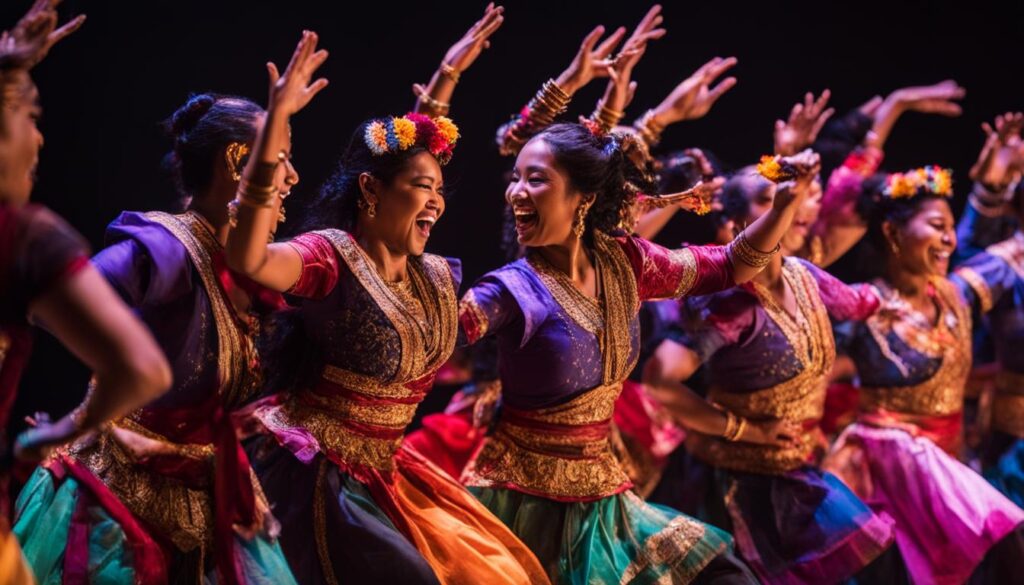

The Benefits of Performing Arts
Beyond personal development, participating in performing arts also improves communication skills. Whether it’s conveying emotions through body language in dance or delivering lines on stage, performing arts teach individuals effective verbal and non-verbal communication techniques. These skills are valuable in social interactions, professional settings, and public speaking engagements.
Furthermore, engaging in performing arts creates a sense of community. It brings together individuals who share a passion for the arts, fostering a supportive and collaborative environment. Through rehearsals, performances, and shared experiences, performers form connections and build relationships. This sense of belonging and camaraderie contributes to a rich and vibrant arts community, promoting cultural diversity and unity.
In conclusion, the importance and benefits of performing arts are undeniable. They provide a platform for artistic expression, personal development, and community building. From fostering creativity and self-confidence to improving communication skills and fostering a sense of belonging, performing arts enrich individuals’ lives and society as a whole.
Types of Performing Arts
The world of performing arts is incredibly diverse, encompassing a wide range of artistic disciplines. Each type offers a unique experience and showcases different skills and techniques. Let’s explore some of the main types of performing arts:
Music
Music is one of the most universal forms of performing arts. From classical symphonies to contemporary pop songs, music has the power to evoke emotions and communicate messages. It encompasses a variety of genres such as jazz, rock, folk, and hip-hop, providing endless opportunities for musicians to express their creativity.
Dance
Dance combines movement, rhythm, and expression to create captivating performances. From classical ballet to modern contemporary dance, this art form allows dancers to tell stories, convey emotions, and showcase their technical skills. Whether it’s the grace and precision of ballet or the energy and freedom of hip-hop, dance captivates audiences of all ages.
Theatre
Theatre brings stories to life through live performances. It encompasses plays, musicals, and other dramatic presentations. Actors use their talents to portray characters and engage the audience in thought-provoking narratives. Theatre is known for its ability to entertain, educate, and challenge societal norms.
Opera
Opera combines music, singing, acting, and stagecraft to create a grand theatrical experience. It often features elaborate costumes, sets, and complex narratives. Opera showcases the power of the human voice and combines it with dramatic storytelling, making it a unique and enchanting form of performing arts.
Magic
Magic performances use illusions and sleight of hand to create a sense of wonder and astonishment. Magicians manipulate objects, perform tricks, and engage the audience’s imagination. Magic is a form of performing arts that combines entertainment and mystery, leaving spectators in awe.
Recitation and Public Speaking
Recitation and public speaking involve the art of delivering speeches, poems, or other written texts in a compelling and engaging manner. It requires effective communication skills, vocal techniques, and the ability to connect with the audience. Recitation and public speaking play a significant role in spoken word poetry, debates, and motivational speeches.
The world of performing arts is vast and continuously evolving. Each type offers its own set of artistic experiences and opportunities for both performers and audiences. Whether it’s the emotional power of music, the elegance of dance, the magic of theatre, or the captivating stories told through opera, performing arts have the ability to transcend boundaries and touch the hearts of people all around the world.
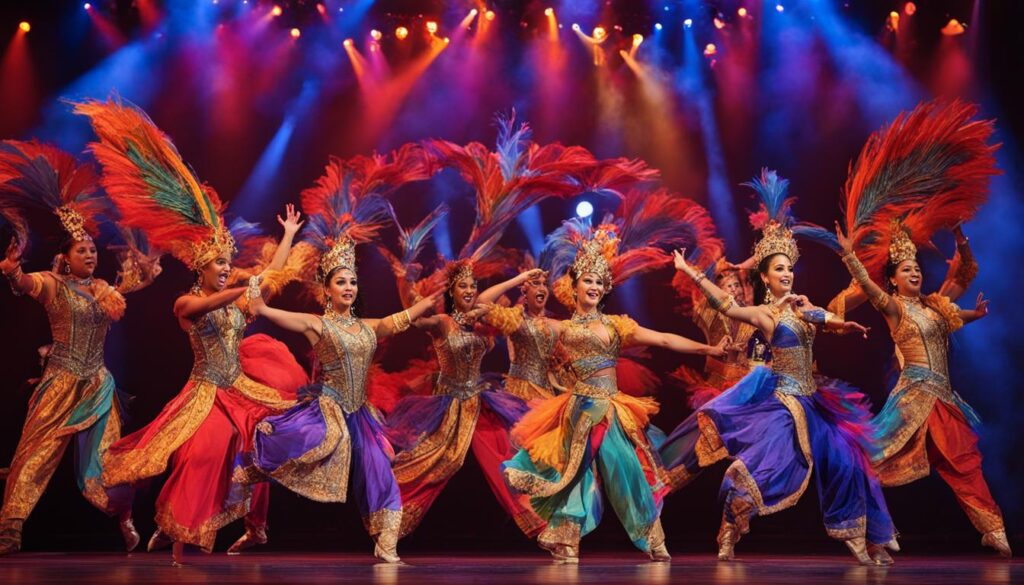

Performing Arts in Education
Incorporating performing arts in education has proven to be incredibly beneficial for students. Not only does it foster creativity and self-expression, but it also helps develop important skills such as teamwork, discipline, and communication.
Through participating in various performing arts activities, students are encouraged to think outside the box, explore their creativity, and express themselves in unique ways. Whether it’s through music, dance, or theater, performing arts education provides a platform for students to showcase their talents and develop a sense of self-confidence.
Furthermore, engaging in performing arts can have a positive impact on academic performance. Studies have shown that students who participate in performing arts activities tend to have improved cognitive abilities, better problem-solving skills, and higher academic achievement. This is because the arts stimulate critical thinking and encourage students to approach learning from different perspectives.
Additionally, performing arts education promotes a sense of community and inclusion. It brings students together from diverse backgrounds and allows them to collaborate and communicate effectively. By working together on group performances or productions, students learn the value of teamwork, respect for others’ ideas, and the importance of collective effort.
Overall, incorporating performing arts in education provides students with a well-rounded education that goes beyond traditional academic subjects. It nurtures their creativity, enhances their cognitive abilities, and equips them with important life skills. By embracing the performing arts, schools can create an environment that fosters personal growth, self-expression, and a lifelong appreciation for the arts.
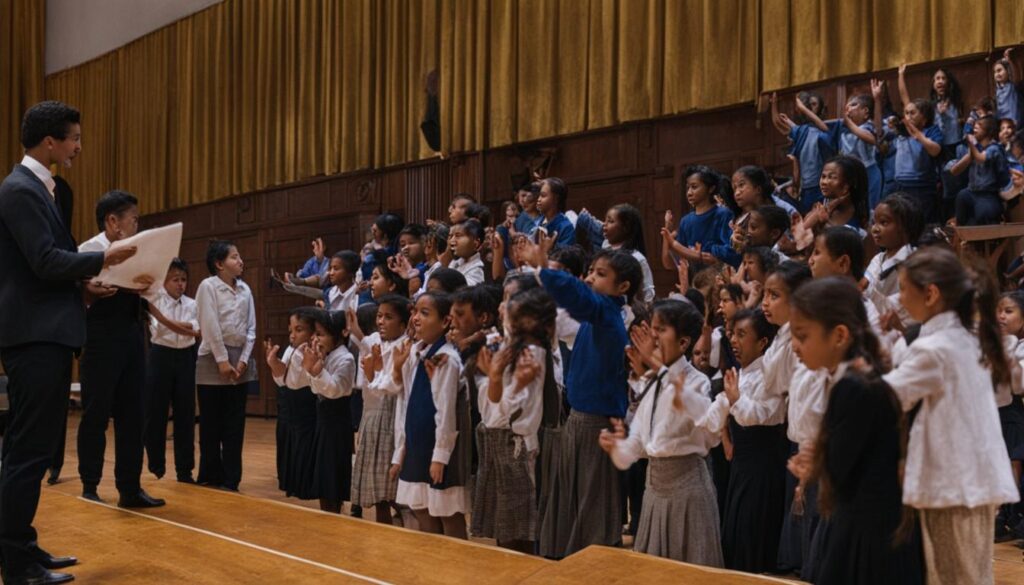

Contemporary and Traditional Performing Arts
Performing arts have evolved over time, giving rise to both contemporary and traditional forms. Contemporary performing arts push boundaries and experiment with new techniques and concepts, often incorporating modern technologies. These innovative performances captivate audiences with their fresh approaches and unconventional narratives. From avant-garde theater productions to experimental dance routines, contemporary performing arts challenge societal norms and redefine artistic expressions.
On the other hand, traditional performing arts preserve cultural heritage and are rooted in long-standing traditions passed down through generations. These art forms honor a rich history, capturing the essence of a particular culture or community. Whether it’s classical music concerts, traditional dance performances, or ancient storytelling techniques, traditional performing arts provide a glimpse into the past and celebrate the cultural identity of a people.
Both contemporary and traditional performing arts contribute to the richness and diversity of the artistic landscape. While contemporary forms strive to push the boundaries and explore new horizons, traditional forms keep alive the customs, values, and beliefs of the past. They exist side by side, each offering unique artistic experiences and eliciting different emotional responses from the audience.
| Contemporary Performing Arts | Traditional Performing Arts |
|---|---|
| Experimentation with new techniques and concepts | Preservation of cultural heritage |
| Incorporation of modern technologies | Rooted in long-standing traditions |
| Challenge societal norms | Celebrate cultural identity |
In the words of renowned contemporary dancer Martha Graham, “No artist is ahead of his time. He is his time.” This sentiment captures the essence of contemporary performing arts, where artists strive to reflect and shape the ever-evolving present.
Exploring the Boundaries
Contemporary performing arts are not bound by traditional rules or conventions. Artists in this realm embrace experimentation, aiming to redefine the boundaries of artistic expression. They often blur the lines between different art forms, combining elements of theater, dance, music, and visual arts to create immersive and multidisciplinary experiences. By pushing the limits of what is considered art, contemporary performers challenge audiences to think critically and engage with the world in new and thought-provoking ways.
- Integration of technology: Contemporary performers harness the power of technology to enhance their artistic creations. They utilize projection mapping, interactive installations, and virtual reality to create immersive and interactive experiences for the audience.
- Breaking traditional narratives: Traditional storytelling often follows a linear structure, while contemporary performing arts embrace nonlinear narratives and abstract storytelling techniques. This allows for a more open interpretation and encourages the audience to actively participate in the artistic experience.
- Social and political commentary: Contemporary performances often tackle pressing social and political issues, shining a light on topics that are relevant to the present moment. They serve as a powerful medium for sparking conversations, challenging societal norms, and promoting social change.
While contemporary performing arts continue to push boundaries and challenge artistic norms, traditional forms remain an essential part of our cultural heritage. Both contemporary and traditional performing arts contribute to the vibrant and diverse tapestry of artistic expressions, captivating audiences and inspiring generations to come.
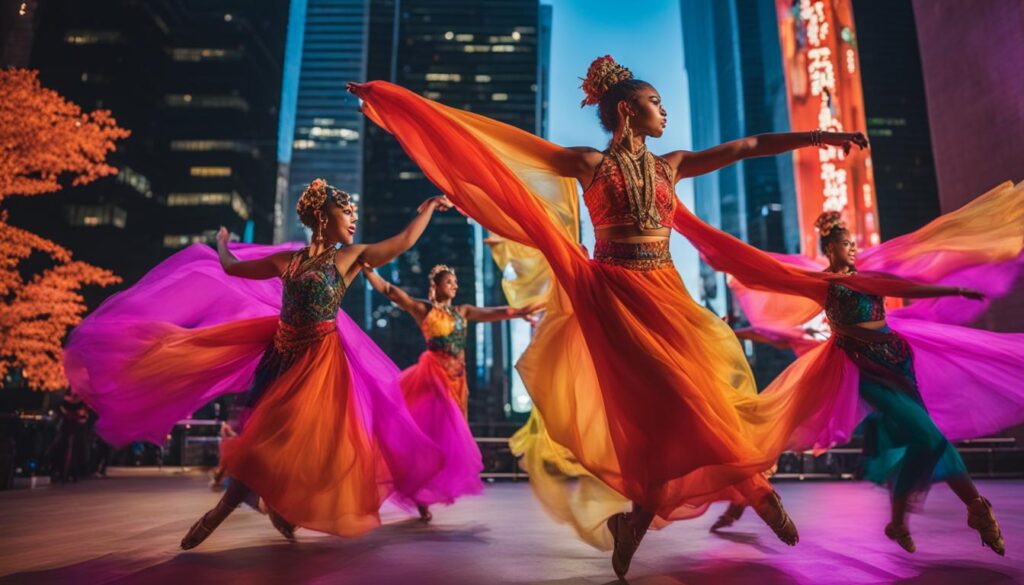

Challenges and Preservation of Performing Arts
Despite their cultural significance and contributions to society, performing arts face numerous challenges that threaten their preservation. These challenges arise from various factors, including standardization, changing cultural practices, tourism, environmental changes, and the homogenization of music. To ensure the longevity of performing arts, safeguarding measures must be implemented to address these challenges and protect the rich traditions they embody.
The Challenges
Standardization is one of the major challenges faced by performing arts today. As cultural practices evolve, traditional art forms can be overshadowed or abandoned in favor of more standardized and commercialized performances. This trend not only diminishes the diversity of artistic expressions but also risks the loss of unique cultural identities.
Additionally, the rise of global tourism can have a detrimental impact on performing arts. In an effort to cater to tourists, traditional art forms may be modified or commodified, losing their authenticity and cultural nuances. This commercialization for the mass market can undermine the integrity and essence of the original art form.
Preservation Initiatives
To preserve performing arts, safeguarding measures must focus on various aspects, including the transmission of knowledge, research, archiving, audience development, and improving training and infrastructure.
Transmitting knowledge plays a crucial role in preserving performing arts. It involves passing down the intricate techniques, styles, and cultural significance from one generation to another. This can be achieved through formal education, mentorship programs, and intergenerational exchanges.
Research and archiving are essential for understanding and documenting the history, evolution, and cultural context of performing arts. By studying and preserving the past, future generations can have a solid foundation to build upon and continue the legacy of these art forms.
Audience development is another vital aspect of preserving performing arts. Encouraging and cultivating a diverse and engaged audience not only ensures the sustainability of performances but also fosters appreciation and support for the arts. This can be achieved through education programs, outreach initiatives, and collaborations with local communities.
Lastly, improving training and infrastructure is crucial for the development and preservation of performing arts. Providing accessible and quality training programs, performance venues, and technical resources can nurture talent, enhance artistic capabilities, and create opportunities for artists to thrive.
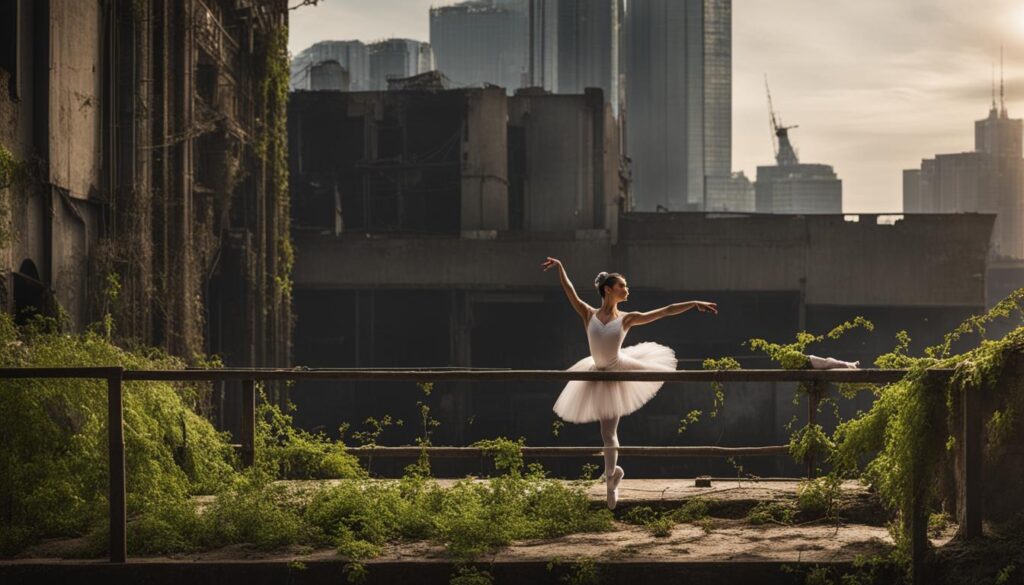

In summary, the challenges faced by performing arts in today’s fast-paced world require proactive measures to ensure their preservation. Striving for a balance between preservation and innovation is key in maintaining the authenticity and cultural diversity of these art forms. By safeguarding the knowledge, engaging audiences, and improving infrastructure, we can empower performing arts to continue captivating and inspiring audiences for generations to come.
Conclusion
In conclusion, performing arts encompass a wide range of artistic expressions that captivate and inspire audiences worldwide. From music to dance to theatre and more, these diverse forms of creativity hold significant cultural value. They provide a platform for individuals to express emotions, opinions, and messages, fostering personal development and self-expression.
Performing arts also play a vital role in education, offering numerous benefits to students. By engaging in these art forms, individuals can develop confidence, communication skills, teamwork, and discipline. Furthermore, performing arts education enhances cognitive abilities and academic performance, providing a well-rounded education.
Both contemporary and traditional performing arts contribute to the richness and diversity of the art form. Contemporary performances push boundaries and experiment with new techniques and concepts, often incorporating modern technologies. Meanwhile, traditional forms preserve cultural heritage and are rooted in long-standing traditions passed down through generations.
However, performing arts face challenges in the modern world. Standardization, changing cultural practices, and external factors like tourism and environmental changes can threaten the preservation of traditional forms. To safeguard these art forms, efforts must focus on knowledge transmission, research, archiving, audience development, and improving training and infrastructure.
In conclusion, performing arts are an essential part of our society, offering cultural significance and numerous benefits. Whether it’s a contemporary performance pushing boundaries or a traditional art form preserving cultural heritage, performing arts continue to delight, inspire, and enrich our lives.
FAQ
What is performing arts?
Performing arts encompass various art forms such as vocal and instrumental music, dance, theatre, pantomime, and more. They are diverse cultural expressions that showcase human creativity.
What is the importance of performing arts?
Performing arts play a crucial role in society by providing a platform for artistic expression and creativity. They allow individuals to convey emotions, opinions, and messages through performances. Additionally, engaging in performing arts has numerous benefits, including personal development, increased self-confidence, improved communication skills, and a sense of community.
What are the types of performing arts?
Performing arts can be categorized into various types such as music, dance, theatre, opera, magic, recitation, and public speaking. Each type offers unique artistic experiences and showcases different skills and techniques. From classical music to contemporary dance, there is a plethora of options for individuals to explore and appreciate.
How does performing arts benefit education?
Incorporating performing arts in education has numerous benefits for students. It helps foster creativity, self-expression, teamwork, and discipline. Performing arts education can enhance cognitive abilities, improve academic performance, and provide a well-rounded education. It also allows students to develop confidence and communication skills that can be beneficial in various aspects of life.
What is the difference between contemporary and traditional performing arts?
Performing arts have evolved over time, giving rise to both contemporary and traditional forms. Contemporary performing arts push boundaries and experiment with new techniques and concepts, often incorporating modern technologies. Traditional performing arts, on the other hand, preserve cultural heritage and are rooted in long-standing traditions passed down through generations. Both forms contribute to the richness and diversity of performing arts.
What are the challenges faced by performing arts and how can they be preserved?
Despite their cultural significance, many forms of performing arts are under threat today. Standardization and changing cultural practices can lead to the abandonment of traditional forms. Furthermore, factors such as tourism, environmental changes, and the homogenization of music can have a negative impact on performing art traditions. Safeguarding measures should focus on transmission of knowledge, research, archiving, audience development, and improving training and infrastructure.
What is the conclusion about performing arts?
Performing arts encompass a wide range of artistic expressions, including music, dance, theatre, and more. They hold cultural significance, offer numerous benefits, and play a vital role in education and society. Whether it’s a contemporary performance pushing boundaries or a traditional art form preserving cultural heritage, performing arts captivate and inspire audiences worldwide.
